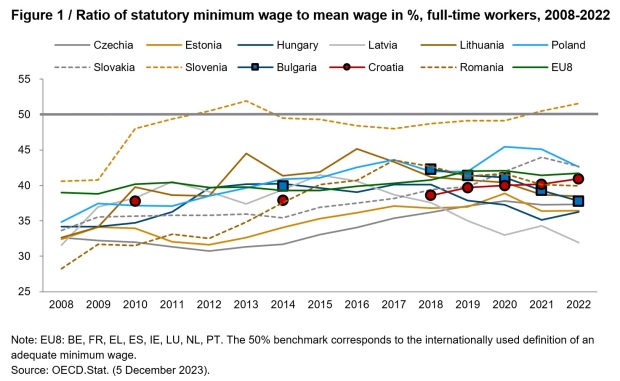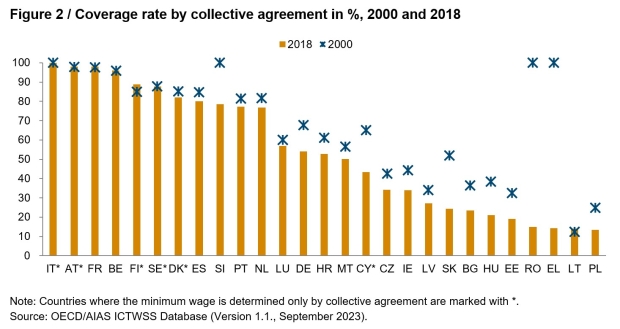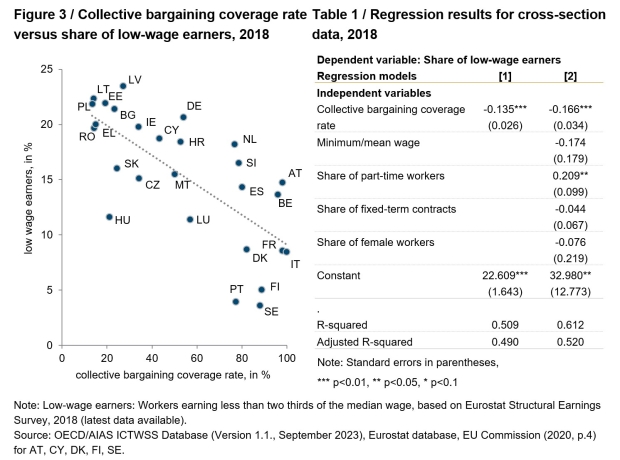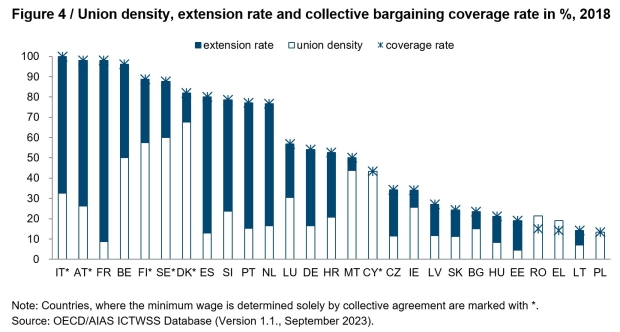The EU minimum wage directive: A chance for decent earnings in Central Eastern Europe
24 January 2024
In 2024, EU governments must implement the directive into national law. Its success will depend on the willingness to accept unions and employer organisations as equal partners
image credit: unsplash.com/Krzysztof Hepner
- Collective bargaining in EU-CEE countries has been under pressure over the past two decades, with coverage rates much lower than in Western or Northern Europe.
- Moreover, in-work poverty and wage dispersion have been on the rise.
- The EU Minimum Wage Directive, adopted in late 2022, is an important step forward in addressing these problems, by promoting collective bargaining and increasing statutory minimum wages.
- In 2024, EU governments are required to incorporate the directive into national law.
- Its success will ultimately depend on the willingness of national governments to accept unions and employer organisations as equal partners and to respect their autonomy in wage setting.
The EU momentum towards more social cohesion
With its proposal for a European Pillar of Social Rights back in 2017 (European Commission, 2017), the Commission promised to strengthen the social dimension of the EU. This major initiative was seen as something of a turnaround for the Commission, following a lengthy period of neglect of social matters: economic issues – particularly the goal of building and deepening the EU single market – dominated the EU playing field. Following the financial crisis of 2008/2009, there was even strong pressure imposed on workers’ rights and bargaining power, when the Troika demanded that governments facing fiscal problems should weaken collective agreements and the social rights of citizens, and trim back the influence of social partnership. However, these kinds of monetary and fiscal policies failed to deliver macroeconomic recovery in the EU, instead bringing about a protracted stagnation and a decline of welfare for many EU citizens. One of the results of this has been an upswing in various countries of parties that oppose the idea of EU cohesion.
Thus, the EU Commission and pro-EU oriented stakeholders finally came to the conclusion that it was high time to change the economic paradigm from liberalism to institutionally embedded capitalism. Moreover, the Commission had to deliver policies that would guarantee more EU-wide cohesion and protection of welfare for all EU citizens (Keune and Pochet, 2023; Müller and Schulten, 2022).
The Social Pillar comprises 20 principles that are designed to provide equal opportunities and access to the labour market, ensure fair working conditions and foster social protection and inclusion for all EU citizens. In these various fields, the Commission promised to deliver concrete actions to regulate minimum standards and promote social progress.
The background of the minimum wage directive
One of the 20 principles of the Social Pillar covers the field of wages. It seeks decent salaries for workers in all EU countries. One of the actions this principle prompted the Commission to do, was to formulate the EU Directive on adequate minimum wages, which was finally adopted in October 2022 (European Commission, 2022).
Following the financial crisis of 2008/2009, it was not only the general risk of social exclusion that increased in many countries, but also – and in particular – in-work poverty, i.e. having a job does not necessarily protect workers from material deprivation. In countries like Czechia, Estonia, Latvia, Slovenia, Bulgaria and Hungary (but also Germany), in 2018 the net income of a single full-time minimum wage earner was below the at-risk-of-poverty threshold (European Commission, 2020). One of the dangers that follow in the wake of in-work poverty, as highlighted by the EU Commission, is that it can reinforce outward migration from poorer regions, which could exacerbate the shortage of skilled workers and population decline in general.
Figure 1 - Ratio of statutory minimum wage to mean wage in %, full-time workers, 2008-2022
While at the time of the financial crisis in 2008, most of the EU-CEE countries had a statutory minimum wage that was relatively low compared to the mean wage – below 35%, except for in Slovenia (see Figure 1) – one can observe a gradual improvement over time. Nevertheless, in many countries – particularly during the most recent period of high inflation – that ratio has again been declining (and thus the income levels of minimum wage earners).
In the Minimum Wage Directive, the EU Commission also addresses the problems of non-coverage and non-compliance with minimum wage rules. This leads to a situation where even an adequate level of the minimum wage does not guarantee that all workers receive decent earnings. Gaps in coverage can result from the legal exemption of specific groups (quite often more vulnerable groups, such as young, migrant, low-skilled workers, etc.) from application of the national minimum wage rules. In countries where the minimum wage rate is determined solely by collective agreement, gaps can result from non-coverage of specific sectors, groups of workers or small and medium-sized enterprises. For example, in Italy about 20% of employees have no minimum wage protection. Furthermore, non-compliance is a serious phenomenon in several countries. Apart from the problem of lower wages, non-compliance is often a result of low-skilled employees having to work unrecorded and unpaid overtime. Eurofound (2023b) estimates that EU-wide in 2018 almost 7% of all employees earned less than the minimum wage rate in force in their country. The highest non-compliance rates are to be found in Hungary (13%), Spain (11%), Germany (9.5%), Italy (9.3%) and Lithuania (8.5%). Relatively low non-compliance rates (of 3% or below) are estimated for Slovakia, Czechia, Latvia, Croatia and Poland, for instance, but also for Greece, Belgium, Finland and the Netherlands.
Figure 2 - Coverage rate by collective agreement in %, 2000 vs. 2008
Something else that is detrimental to the development of salaries (not only of low-wage earners)[1] is the decline throughout Europe over the past two decades in the proportion of workers covered by collective agreements. (see Figure 2). Whereas in most Northern and Western European countries (except Germany) the decrease has been fairly small, in almost all the Central and Eastern European EU member states there has been a sharp decline, particularly following the financial crisis of 2008/2009. Nowadays collective agreement coverage rates in EU-CEE are much lower than in the rest of the EU.
The main elements of the directive
The Minimum Wage Directive has three major goals. First, governments should provide for an adequate minimum wage – i.e. one that allows a decent standard of living. Second, governments should enhance the effective access of workers to minimum wage protection. And third, an increase should be encouraged in the share of employees covered by a collective agreement.
As an adequate level for a minimum gross wage, the Commission highlights the internationally used benchmarks of 50% of the national mean wage and 60% of the national median wage and underscores the importance of ensuring that the minimum wage covers the cost of living. Governments that use a statutory minimum wage in their country should establish procedures – or refine existing ones – in order to involve the social partners in setting and continuously updating the minimum wage.
In order to enhance minimum wage protection for all workers, the directive envisages that governments should provide effective and adequate controls and that labour inspectorates should undertake field inspections. Governments should also guide and help those authorities to develop the necessary capabilities.
Figure 3 - Collective bargaining coverage rate versus share of low-wage earners, 2018
The importance of high collective agreement coverage rates to reduce the share of low-wage earners is obvious (see Figure 3). Applying a cross-section econometric approach (Table 1) we find that the share of low-wage earners is associated – statistically significantly and negatively – with coverage rates, but not with the ratio of minimum wages to mean wages. Other factors that were expected to influence the share of low-wage earners – i.e. the share of female workers and fixed-term employment contracts – were found to be insignificant. Only a higher share of part-time employees was positively associated with the share of low-wage earners. Higher collective bargaining coverage rates are thus essential to reduce wage inequality and the extent of the low-pay sector.
The Minimum Wage Directive stipulates that, in order to increase coverage rates, all countries with rates of below 80% should develop specific actions to strengthen the capacities of the social partners and foster collective bargaining – not only at the company level, but also particularly at the sectoral and the cross-industry level. An appropriate action plan is to be adopted following consultation with the national social partners and is to be reported on to the Commission by the end of 2025 at the latest. The plan should set out a clear timeline and concrete measures to progressively raise the rate of collective bargaining coverage.
The Commission has announced that it will support the process of (re)establishing collective bargaining and tripartite social dialogue in the member states in many ways over the coming years. Financial support for the capacity building of social partners is provided by the European Social Fund Plus (ESF+). In particular, this should support social partners in setting up more centralised bargaining structures. However, success depends very much on developments on the national playing field – and particularly on whether the capacity building of unions and employer organisations is supported by the government in question. Collective bargaining and tripartite social dialogue could gain momentum if governments accept unions and employer organisations as equal partners in wage setting and social dialogue. The effective enhancement of coverage rates will be a particular challenge in the EU-CEE countries.
Measures to foster higher collective bargaining coverage
As regards the content of the action plans that the member states have to deliver, the directive prescribes no specific content, leaving it up to the national governments to deliver measures in line with national practices, and thus also respecting the social partners’ autonomy. However, in its impact assessment, the EU Commission names some provisions that could effectively support an increase in collective bargaining coverage rates: representativeness and extension rules, duration of collective agreements and peace clauses (European Commission, 2020, pp. 177f).
Representativeness and extension rules: The representativeness criteria of social partners are often defined by law. They determine how many of the enterprises in an industry or workers in a company or industry must be members of the employer organisation or union for these social partners to be recognised as representative of the companies and workers. Only representative social partners can enter into meaningful collective bargaining. Governments need to formulate these regulations on representativeness in such a way as to facilitate collective agreement bargaining at a more centralised level (see also Hassel, 2022). Furthermore, regulations on extension are important in order to increase coverage by collective agreement. When representative social partners have reached a collective agreement, the reach of the latter is extended from the signatory parties to all workers in a sector of a region or countrywide. Without effective extension rules, we would see much lower collective bargaining coverage rates in most EU countries (Hijzen and Martins, 2016).
An indication can be given by comparing union density and collective bargaining coverage rates (Figure 4). In many countries with higher collective bargaining coverage rates, these are achieved thanks not only to higher union density rates, but also to widespread use of extension rules. Thus, in most EU-CEE countries, more generous regulations covering representativeness and extension could easily increase collective bargaining coverage rates.
Figure 4 - Union density, extension rate and collective bargaining coverage rate in %, 2018
Duration of collective agreements: If the duration period of a collective agreement is long (or even indefinite), that benefits workers, since it keeps them covered even if no renegotiations take place. Ultimately it fosters stability and social peace, since the security of wages and working conditions is preserved.
Peace clauses: In order to make collective agreements effective, enforcement is required. This can be encouraged by peace clauses – i.e. agreements that have been reached at a higher level of bargaining (the national or sectoral level) must also be enforced at lower levels (sectoral or company level). Mediation and arbitration bodies can further help smooth negotiations.
In its Minimum Wage Directive, the EU Commission stresses moreover the importance of public procurement at the national level, in order to foster effective implementation of minimum wage protection and the increase in collective bargaining coverage. It underlines the need to demand compliance in the awarding and performance of public procurement and concession contracts.
Further measures that would help attain the goals of the Minimum Wage Directive include the elements of monitoring and data collection. The EU Commission will implement a system of reporting, in order to support the process towards higher collective bargaining coverage rates and decent minimum wages (European Commission, 2022).
Expected effects of decent levels of minimum wages
In many EU-CEE countries, a large share of workers earns the statutory minimum wage. In Slovenia, Bulgaria, Romania and Poland, this affects more than 10%; in Hungary, Latvia, Lithuania, Slovakia and Croatia, it still applies to between 5% and 10% (Eurostat, 2023). Thus, an adequate level of the minimum wage (and enforced compliance) is of the utmost significance for those workers and their families, if they are to make ends meet and avoid in-work poverty.
For a long time the view on minimum wages was rather critical on the part of many, particularly liberal policy makers. A decent level of the minimum wage was seen as a danger to the viability of small and medium-sized enterprises and to the prospects of low-skilled workers in remote areas finding and retaining employment. Empirical research found, however, that the welfare effects of the minimum wage far outweigh any possible negative employment effects. Overall, the literature detects on average only very slightly negative or non-existent employment effects (Card and Krueger, 2016; Dube, 2019; Eurofound, 2023a). The results are not that consistent when it comes to low-skilled and young workers; but for that group, too, job losses seem to be small (e.g. Cengiz et al., 2019). In its impact analysis of the Minimum Wage Directive, the EU Commission performed microsimulations, in order to assess any possible negative employment effects. It is estimated that lifting the minimum wage floor to 60% of the median wage would result in a small negative employment effect of 0.6% or below in most EU-CEE countries. In those countries that in 2018 had the lowest minimum-to-mean-wage ratios or a high share of minimum wage earners (Romania, Poland, Estonia and Bulgaria), the effects could be greater (European Commission, 2020, pp. 182ff).
Conclusions
The EU Minimum Wage Directive, adopted in late 2022, is an important step forward in addressing the problem of in-work poverty by increasing the statutory minimum wage. In many EU-CEE countries, a large share of workers earns the statutory minimum wage: in Slovenia, Bulgaria, Romania and Poland that applies to more than 10%; in Hungary, Latvia, Lithuania, Slovakia and Croatia, the figure is still 5-10%. Thus, an adequate level of the minimum wage (and enforced compliance) is of the utmost significance for those workers and their families in terms of making ends meet and avoiding in-work poverty. Moreover, the Minimum Wage Directive of the EU addresses the promotion of collective bargaining, in order to reduce wage dispersion and increase welfare for low-wage earners.
Footnotes:
[1] Low-wage earners are classified by the European Commission as workers earning less than two thirds of the hourly median wage, based on the Eurostat Structural Earnings Survey.
References:
Card, D. and A.B. Krueger (2016), Myth and measurement: The new economics of the minimum wage – Twentieth-anniversary edition. Princeton University Press.
Cengiz, A., A. Dube, A. Lindner and B. Zipperer (2019), The effect of minimum wages on low-wage jobs. Quarterly Journal of Economics, 134(3), 1405-1454. https://doi.org/10.1093/qje/qjz014
Dube, A. (2019), Impacts of Minimum Wages: Review of the international evidence, Independent report prepared for the UK Low Pay Commission. https://assets.publishing.service.gov.uk/media/5dc0312940f0b637a03ffa96/impacts_of_minimum_wages_review_of_the_international_evidence_Arindrajit_Dube_web.pdf (5.12.23).
Eurofound (2023a), Minimum wages in 2023: Annual review, Minimum wages in the EU series. Luxembourg: Publications Office of the European Union.
Eurofound (2023b), Minimum wages: Non-compliance and enforcement across EU member states – Comparative report. Luxembourg: Publications Office of the European Union.
European Commission (2017), European Pillar of Social Rights. https://data.europa.eu/doi/10.2792/95934 (5.12.23).
European Commission (2020), Commission Staff Working Document Impact Assessment Accompanying the document Proposal for a Directive of the European Parliament and of the Council on adequate minimum wages in the European Union. SWD/2020/245 final. https://eur-lex.europa.eu/legal-content/EN/TXT/?uri=SWD:2020:245:FIN (5.12.23).
European Commission (2022), Directive (EU) 2022/2041 of the European Parliament and of the Council of 19 October 2022 on adequate minimum wages in the European Union. https://eur-lex.europa.eu/legal-content/EN/TXT/PDF/?uri=CELEX:32022L2041 (25.11.23).
European Commission (2023), Proposal for a Council Recommendation on strengthening social dialogue in the European Union. https://eur-lex.europa.eu/legal-content/EN/TXT/?uri=CELEX%3A52023DC0038 (25.11.23).
Eurostat (2023), Statistics explained: Minimum wage, https://ec.europa.eu/eurostat/statistics-explained/index.php?title=Minimum_wage_statistics (5.12.23).
Hassel, A. (2022). Round table. Mission impossible? How to increase collective bargaining coverage in Germany and the EU. Transfer: European Review of Labour and Research, 28(4), 491-497. https://doi.org/10.1177/10242589221149513
Hijzen, A. and P. Martins (2016), No extension without representation? Evidence from a natural experiment in collective bargaining. IMF Working Paper WP/16/143. https://www.imf.org/external/pubs/ft/wp/2016/wp16143.pdf (5.12.23)
Keune, M. and P. Pochet (2023), The revival of Social Europe: Is this time different? Transfer: European Review of Labour and Research, 29(2), 173-183. https://doi.org/10.1177/10242589231185056
Müller, T. and T. Schulten (2022), Die Europäische Mindestlohnrichtlinie – Paradigmenwechsel hin zu einem Sozialen Europa [The European Minimum Wage Directive – Paradigm shift towards a Social Europe], Wirtschaft und Gesellschaft, 48(3), 335-364.




